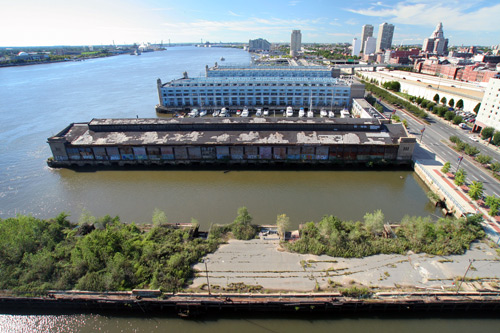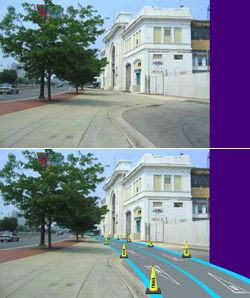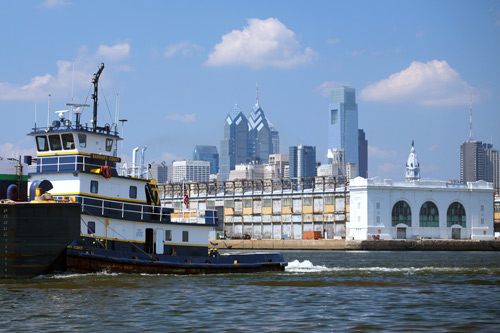26 March 09: The Possible City:
Piecing Piers
 by Nathaniel Popkin March 26, 2009 "You have to do it piece by piece and mile by mile," said Philadelphia's Commerce Director Andy Altman earlier this month, while announcing progress in the city's effort to reshape the Delaware waterfront. The city will adopt Penn Praxis' plan to restore Philadelphia's intimate urban fabric to the waterfront. Altman's statement reflects this philosophy -- sustained redevelopment will result from dozens of small steps. Penn's Landing, the last big vision, is often called a failure. Part of why it's a failure to some -- it feels inorganic, separated from the fabric of the city (and strangely, the river itself) -- drove Penn Praxis to break down the vast landscape and repair its faulty connections. "Piece by piece, mile by mile" is also a measure of the impact of recession, neighborhood control, and fragmented land ownership on and around Delaware Avenue. At present, superblock ideas have no credence. The first piece will be the conversion of Pier 11, at Race Street, into a park, a $1 million project funded by the William Penn Foundation. Altman said the piers along the Hudson, in New York, are a model for the park. (Someone ought to investigate the St. Lawrence riverfront in Montreal, a much closer comparison in almost all ways.) A riverfront playground at Race Street is most certainly a good idea. It's a spectacular site. Good landscape design will reinforce it as a hinge -- connecting multiple places with the river all at once. But as passive space, it will need programming. The Great Plaza -- isn't it too just another small piece of the puzzle? -- fails largely because it has little quotidian purpose. Though in part this first piece is meant to help carry the pedestrian north, it feels to me like a lonely bookend. So I worry. Are we building yet another noble public space that will be hard to get to and boring to boot?  We might instead use this first pass to visually clarify what everyone hopes will be a larger central waterfront. Why not give Pier 11 a southern twin and mark out the broad territory?
A bike trail from Penn's Landing south to Pier 70 has been approved and funded. It will help pull river-users south -- into the car zone. But only some pedestrians and bikers are headed
to Wal-Mart. The rest of us need things to engage and delight us.
We might instead use this first pass to visually clarify what everyone hopes will be a larger central waterfront. Why not give Pier 11 a southern twin and mark out the broad territory?
A bike trail from Penn's Landing south to Pier 70 has been approved and funded. It will help pull river-users south -- into the car zone. But only some pedestrians and bikers are headed
to Wal-Mart. The rest of us need things to engage and delight us. (The illustration at right, by Wallace Roberts Todd for Center City District and Penn Praxis' Central Riverfront plan, is also in a story about the trail in the Summer of the Delaware HERE.) The City owns Municipal Piers 38 and 40, at Christian Street, two of the most handsome structures on the Delaware. Painted bright white and marine blue, they're luminous proof of our lack of imagination. They glow like the whitewashed and blue-trimmed houses of a Mediterranean cliffside village. Pier 38 is a warehouse used by the Philadelphia Regional Port Authority; Pier 40 houses a private self-storage and truck rental business. What's more, and unlike much of the waterfront, the grid nearly reaches here. Only minor reinforcements are needed. I had long thought Pier 40 would make a fine "Museum of the American Polyglot," a living monument to the slow accumulation of the American soul. The river, call it what you will -- Lenapewihittuck, Zuydt Revier, Svenske, South River, Delaware -- is its source. They came -- first Algonquians and their descendents the Lenni Lenape, the Susquehannock, brothers of the Iroquois, and before 1640, Dutch and English and Swedish ships filled with Scots and Poles, Germans and Fins, and of course, Dutch and English and Swedes. A century later, there were more languages spoken on the wharves and in the workshops of this waterfront than probably anywhere else in the world. More foreign ships, more religions practiced, more shades of skin. The ever-widening gene-pool is one the great American stories, and Philadelphia's consistent role in that story is undertold, but a museum may be unrealistic and feel dogmatic. It also may not be the kind of active use the site -- and the waterfront -- requires. Similar Montreal piers, though larger, combine retail and commercial uses. It's not that hard to imagine a pleasant combination of a café, a restaurant or two, a bar, each with tables open to the water, and an IMAX theater. Assuming a bike/walking path is assembled, a bike share station could be added. This sort of investment would put some amenities at the physical scale of biker/runner/pedestrian (in comparison, for example, to the massive scale of a casino). Amazingly, they would be among the first of their kind on the waterfront. Still, the ideas don't seem to resound, do they? Perhaps then it's because the piers themselves are so striking they remain so underutilized. No one can imagine a use quite commensurate with their beauty. So we leave it to "Dredging=Jobs." But Altman's point is that we have to start trying things. We already own these lovely structures. Without much sweat -- the Port hates to give up control of real estate, but this is insignificant in comparison to its Southport expansion plans -- Piers 38 and 40, like Pier 11, can be made available for the pleasure, interest, and joy of people. So what should it be? The busy Atwater Market marks a similar location in Montreal, but I'm not sure this site can handle a waterfront Reading Terminal. I'd like to hear your ideas. Perhaps we can collect them, photoshop/render the best, and effectively make the case for these two piers. Until then, I suppose they remain a rather significant missing piece.  –Nathaniel Popkin nathaniel.popkin@gmail.com For more on The Possible City, please see HERE. For Nathaniel Popkin archives, please see HERE, or visit his web site HERE. |
|
• 7 January 09: Slow Moving, City Alive • 20 November 08: Of weights and visions • 20 October 08: Dreams of a Magic City • 26 September 08: The opposite of decline • 19 September 08: "To see something greater" • 18 September 08: Dwindling/rekindling possibilities • 26 August 08: TPC, NOW AVAILABLE IN PAPERBACK • 26 June 08: The Mother of Invention • 29 Apr 08: "This is not pie-in-the-sky" • 1 Apr 08: Recess/Re-assess • 7 Mar 08: One-City Art Movement, Open to Everyone • 24 Feb 08: Too late for the streetscape? • 15 Feb 08: "It really could be something." • 18 Jan 08: Estuary of Dreams • 11 Jan 08: More than shelter • 10 Jan 08: Nature's balance • 6 Dec 07: Snake uprising • 4 Dec 07: A Junction that ought to be • 6 Nov 07: Around the Mulberry Tree we go • 29 Oct 07: Wondering about wandering • 5 Oct 07: No other way • 21 Sept 07: Here is the Possible City |
